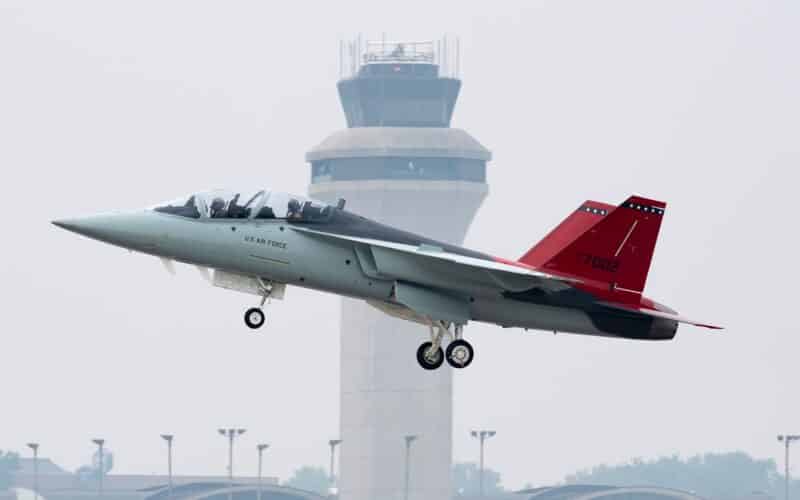Aerospace
Boeing T-7A Red Hawk completes first flight with US Air Force

The U.S. Air Force’s first T-7A Red Hawk made its first flight, marking up the program’s engineering and manufacturing development (EMD) phase. This flight was completed by Boeing on behalf of the service.
During the 1 hour and 3-minute flight, U.S. Air Force Maj. Bryce Turner, 416th Test Squadron, and Steve Schmidt, Boeing T-7 chief test pilot, validated key aspects of the aircraft and demonstrated the power and agility of the Air Force’s first advanced trainer to be digitally designed, built and tested. The aircraft is one of five EMD aircraft that will be delivered to the Air Force Air Education and Training Command for further testing.
The T-7A’s vibrant red tails are a tribute to the Tuskegee Airmen, the first African American U.S. military aviators who flew red-tailed fighters during World War II.
The T-7A will enhance warfighter training through:
- Improved pilot readiness: The all-new advanced pilot training system uses high-resolution ground-based training systems and simulators to deliver robust and realistic integrated live, virtual and constructive training capabilities.
- Safety: Model-based engineering enabled testing throughout the aircraft’s design and build to help ensure safety before the first flight. The T-7A’s cockpit egress system is the safest of any trainer.
- Flexibility for any mission: With open architecture software and digital fly-by-wire controls, the T-7A supports training for a wide variety of fighter and bomber pilots and can evolve as technologies, threats and training needs change.
In 36 months, the T-7A went from a solid concept through flight testing. Model-based engineering, 3D design, and sophisticated manufacturing techniques boosted first-time quality by 75% and decreased assembly times by 80%.

Aerospace
Boeing Transfers Rocket Stage to NASA, Paving Way for Human Moon Mission

Boeing has achieved a significant milestone by providing NASA with the second core stage of the Space Launch System (SLS) rocket.
This crucial component, crafted at NASA’s Michoud Assembly Facility (MAF), is set to propel the Artemis II crew into lunar orbit, marking humanity’s return to deep space after a 50-year hiatus.
The monumental Boeing-built rocket stage, the largest element of the Artemis II mission, will embark on a journey aboard the Pegasus barge, traveling 900 miles to NASA’s Kennedy Space Center.
Comparison of two legendary aircraft B777x vs B747 aircraft:Click here
Upon arrival, it will be meticulously integrated with other essential Artemis II components, including the upper stage, solid rocket boosters, and NASA’s Orion spacecraft within the iconic Vehicle Assembly Building. This intricate integration process is a vital step toward the eagerly anticipated Artemis II launch, slated for 2025.
“Boeing-built products helped land humankind on the moon in 1969, and we’re proud to continue that legacy through the Artemis generation,” remarked Dave Dutcher, vice president and program manager for Boeing’s SLS program. “Together, with NASA and our industry partners and suppliers, we are building the world’s most capable rocket and paving the way to deep space through America’s rocket factory in New Orleans.”
NASA, Lockheed Martin Reveal X-59 Quiet Supersonic Aircraft:Click here
The delivery of Core Stage 2 marks a significant achievement in the evolution of the SLS rocket. Towering over 200 feet and powered by four RS-25 engines, this core stage, coupled with two solid-fueled booster rockets, will generate a staggering 8.8 million pounds of thrust. This immense power is crucial to launching Artemis II and future missions into the vast expanse of space.
The SLS rocket stands unparalleled in its capability to transport both crew and substantial cargo to the moon and beyond in a single launch. Its extraordinary capacity will facilitate the delivery of human-rated spacecraft, habitats, and scientific missions to destinations including the moon and Mars, ushering in a new era of space exploration.
-

 Travel1 week ago
Travel1 week agoAir India to Expand US Operations with Three New Routes After a Decade
-

 Travel2 weeks ago
Travel2 weeks agoWhy We Should Avoid These Stamps in a Passport
-

 Airlines1 month ago
Airlines1 month agoInvestigations Reveal Fake Chinese Titanium in Boeing and Airbus Jets
-

 Tech4 weeks ago
Tech4 weeks agoChina’s CATL Plans 1,800-Mile Electric Plane Launch by 2027
-

 Airport3 days ago
Airport3 days agoTop 10 Largest Airports in the World by Size
-

 Aerospace4 weeks ago
Aerospace4 weeks agoChina’s Fighter Jets Turn Wings into Autonomous Drones
-

 Airlines4 days ago
Airlines4 days agoAir India Rolls Out A350s for Delhi-New York JFK and Newark Routes
-

 Defence3 weeks ago
Defence3 weeks agoBoeing Enhances Chinook with New Engines and Block II Upgrades at $96 Million







